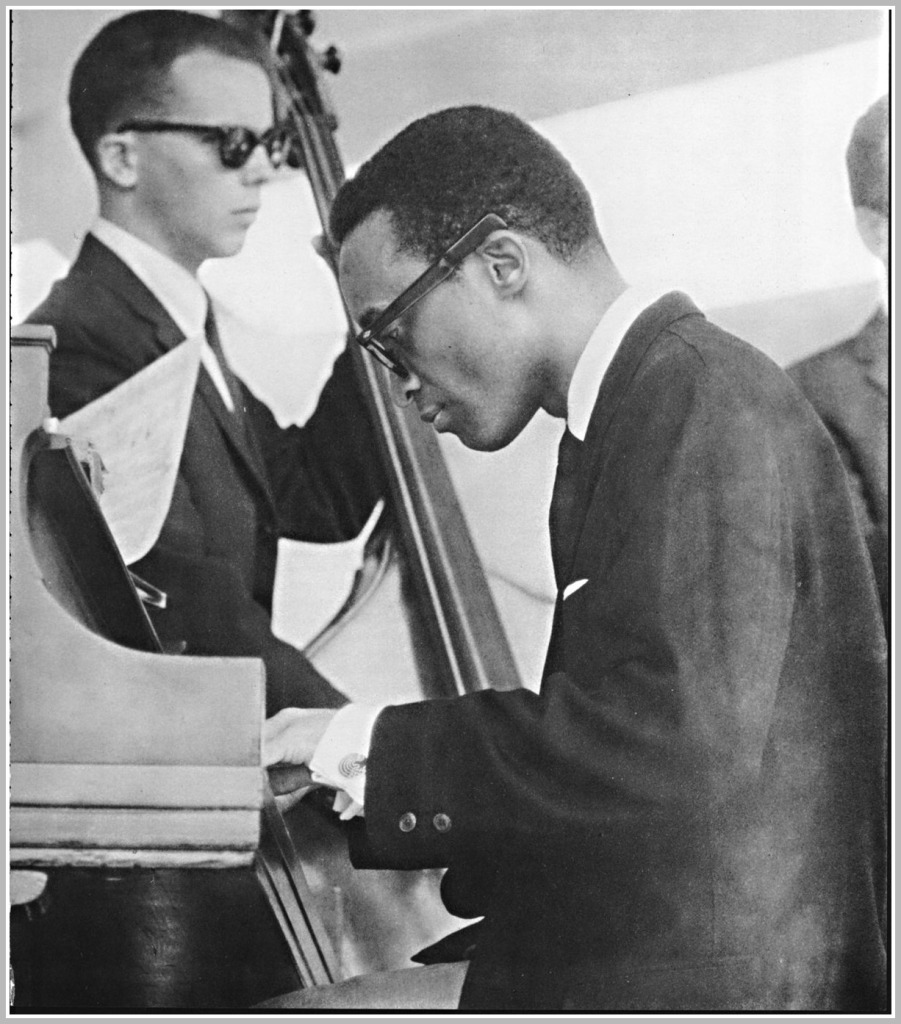
Buell Neidlinger (bass) and Cecil Taylor (piano) at Newport in 1957
What turned out to be Buell Neidlinger’s final contribution to this blog arrived on March 9, in response to a piece about Keith Jarrett’s latest release. Buell had seen the accompanying photograph of Jarrett, Gary Peacock and Jack DeJohnette relaxing on stage at Boston’s Symphony Hall: “Thought I recognised the floor… worked there for three years,” he wrote. In 1967 he had joined the Boston Symphony Orchestra and also the faculty of the New England Conservatory of Music, where he taught bass and chamber music and, with George Russell, established the first jazz department of a major music school.
It astonished me when Buell sent some words to this blog, commenting on something I’d written about Cecil Taylor. His participation in Cecil’s trio version of “This Nearly Was Mine” made a huge impression on me when I first heard it in the early ’60s. It remains a favourite, not least for the way Buell’s bass shadows Taylor’s piano inventions with such devotion and beautiful note-choice.
As a young cello prodigy, born in New York City and brought up in Connecticut, Buell studied with Gregor Piatigorsky and had lessons from Pablo Casals. After switching to double bass, he played with Billie Holiday and Lester Young, with Hot Lips Page and Herbie Nichols, with Igor Stravinsky and Leopold Stokowski, with Cecil Taylor and Ornette Coleman, with Barbra Streisand and Frank Sinatra, with John Cage and George Crumb, with Duane Eddy and Roy Orbison, with Sir John Barbirolli’s Houston Symphony and Neville Marriner’s LA Chamber Orchestra, with the Beach Boys and Earth Wind & Fire, with Frank Zappa and the Eagles.
The instrument he played on “This Nearly Was Mine” was the same one he used on “Hotel California”. Once owned by King George III, it had been played in the first performance of Handel’s Messiah. “I sold it years ago to a girl in Hollywood for $15,000,” he told me during the course of our only conversation, on the telephone from his home in Washington State.
He also talked about his friendship with James Jamerson, whom he had met in a Hollywood studio. Buell had acquired his first bass guitar in 1953, but by the time he bumped into Jamerson on a Michael Jackson date he had become a first-choice double bassist in the studio orchestras. “Basically he was through already,” Buell said. “When Berry Gordy moved to LA, he basically signed the death warrants of a bunch of great musicians.”
Neidlinger remembered the Motown studio in Hollywood as the first place he worked where they had a transmitter. “You’d cut your shit,” he said, “and you’d go out to the car park and listen to it on the radio. If it didn’t sound good, you’d go back and do it again.”
He also remembered Jamerson’s addiction to alcohol. “He was living in a motel on Hollywood Boulevard. It was pretty ugly. After we had a meal on Santa Monica Boulevard, he invited me back. Whisky and gin bottles everywhere. He had a sliding closet. There weren’t many clothes in there, but there was his upright bass with no case. He played Fender bass on the Motown hits, of course, but really he was an upright bass player.”
Buell had strong views about everything, including bass players. He thought Paul Chambers was the greatest bass player who ever lived. He liked players who didn’t try to play the instrument as if it were a guitar, playing too many notes at the top of the instrument’s range. (This was a man whose first paying job in New York was as a dep for the ailing Walter Page, who had been the bassist in Count Basie’s pre-war band.) When Maurice White died, he sent a note to the blog saying that the EW&F man was the greatest drummer he’d ever recorded with.
In his later years Buell moved to Washington State, where he lived with his wife, Margaret Storer, another bassist. He had a group called Buellgrass, including the fiddler Richard Greene, which played his version of bluegrass music, and he and Margaret played baroque music with friends — he back on cello, she on violin.
Did I mention that he depped in Thelonious Monk’s quartet for a night at the Five Spot in 1957, alongside John Coltrane and Shadow Wilson? And for Charlie Haden in Ornette’s quartet in 1959, also at the Five Spot? And that his first No 1 was Tony Bennett’s “I Left My Heart in San Francisco”, on which he played in the string section? He seemed to have cherished every note, every encounter, every experience. I’m not sure there’s ever been anyone quite like him, or will be again.

